 |
February 2020
|
February 2020 // Volume 58 // Number 1 // Research In Brief // v58-1rb3
Identifying Forest Health Gaps: A Needs Assessment of Tree and Forest Health Extension Education
Abstract
There is growing demand for a broader conception of tree and forest health by commercial and private timberland owners, who make up a substantial proportion of Extension clientele in the southeastern United States. There has been little research to comprehensively capture and represent Extension agents' needs, concerns, and perceived barriers as they respond to client questions and requests regarding tree and forest health topics. Our needs assessment results highlight needs and barriers Extension agents encounter as they address tree and forest health requests from clientele. We provide recommendations for research and practical applications for improving relevant resource support in Extension.
Introduction
The forestry sector has a significant economic impact in the United States, employing nearly 1 million workers and accounting for approximately 4% of the total U.S. manufacturing gross domestic product (American Forest and Paper Association, 2018). Forests also provide critical ecosystem functions and services, including the provisioning of food, water, raw materials, fuel, medicinal resources, system regulation, carbon sequestration, and erosion control—all of which are beginning to be better understood, quantified, and valued (Gamfeldt et al., 2013). In Florida, for example, for every $1 invested in timber production, the value of the ecosystem services has been estimated at $14 (Escobedo & Timilsina, 2012). Currently, climate variability and invasive species disruption are two of the major factors threatening forest health (Lovett et al., 2016; Millar & Stephenson, 2015), challenging private forest landowners to adapt to dynamic forest conditions and natural hazards (Coulson & Stephen, 2008; Vose, Peterson, & Patel-Weynand, 2012). Emerging pests and diseases of trees in the United States are estimated to have a significant annual cost to landowners, municipalities, and state governments, with wood-boring insects alone causing "nearly $1.7 billion in local government expenditures and approximately $830 million in lost residential property values" in the continental United States (Aukema et al., 2011, p. 5). These conditions result in an increased demand among landowners and land managers for information on sustainable forest management to promote forest health (Sagor, Kueper, Blinn, & Becker, 2013; Zobrist & Rozance, 2015).
To address this issue, Cooperative Extension services have developed multi-institutional partnerships to ensure the delivery of evidence-based education to promote forest health and resilience. Efforts such as the Proactive Forest Health and Resilience (ProForest) initiative (http://proforesthealth.org/) and the Southern Regional Extension Forestry (SREF) Forest Health and Invasive Species Program (https://sref.info/) support Extension educators in integrating forest health into their programs by facilitating educational and technical services. This strategic priority aligns with the assertions of Sagor et al. (2013) that Extension forestry serves as a primary source for educational programs and resources to support sustainable forestry management. Sagor et al.'s (2013) comprehensive review of state-level Extension programming showed an increased demand among landowners and agents for instruction in forest health, invasive species, and the effects of climate change on forests. A recent needs assessment conducted by SREF similarly indicated that forest health was the third most important programming area for Extension agents in the Southeast (SREF, 2017).
With these emerging demands and steadily declining budgets, it is vital to assess the availability of relevant and up-to-date educational materials for Extension agents to use with landowner audiences. Understanding the needs and priorities of Extension agents, particularly those agents operating at the county level, provides an opportunity to address existing gaps and enhance program efficacy proactively. We found few recent explorations of these needs. The most recent assessments of forestry-related educational material needs occurred in the late 1990s and addressed urban forest health and the forest product industry (Hansen & Smith, 1997; Pokorny, 1998).
Purpose and Objectives
The purpose of our study was to determine the educational material needs of county Extension agents who guide clients on issues related to tree and forest health. Our objectives were to identify (a) the scope of client segments and distribution of different types of client requests, (b) specific challenges and barriers to meeting clients' needs in a timely and effective manner, (c) topics for which new educational materials are needed, (d) the most useful informational formats for addressing client needs, (e) features of importance for materials distributed to clients, and (f) Extension agents' preferred outlets for accessing information and research results.
Methods
We used a mixed-methods multiphase approach to identify and describe various components of tree and forest health educational material needs of Extension agents. During the initial formative phase, we conducted key informant interviews to explore and understand agent needs. We used the results from this initial phase to inform a follow-up survey intended to help forestry researchers and forestry subject specialists better understand the extent of the Extension agent needs. Our population of interest was Extension agents in Florida. The University of Florida Institutional Review Board for Human Subject Research approved the study. We conducted the project in the summer and fall of 2018.
For the initial formative phase, we conducted 13 semistructured telephone interviews with nine Extension agents and four county Extension directors from 13 counties. We analyzed the results collected from the qualitative phase using a three-step constant comparative process (Kolb, 2012). Our lead author first assessed the data line by line and assigned codes in emergent categories and then continued to analyze until codes and categories became well-defined. Next, the lead author examined the individual categories to establish relationships with other categories and then shared these merged themes with the rest of our author team to review, discuss, and reach a consensus. The collaboratively produced final themes (see Appendix A) informed the design of our second-phase survey protocol, which we then distributed more widely to determine the generalizability and extent of need described by first-phase responses.
For the second phase, we used an online survey that was validated by an expert panel of evaluation specialists, forest health specialists, and survey methodologists. The survey questionnaire contained six main items. In Table 1, we provide descriptions of these items. We designed and administered the survey using the tailored design method (Dillman, Smyth, & Christian, 2014) and distributed the survey to Extension agents (N = 101) who had forestry, horticulture, agriculture/natural resources, or sustainability assignments. Not all participants answered all parts of every item. The maximum response rate was 57% (n = 58), although the response rate fluctuated moderately across questions.
| Item | Question text | # of response items | Response scale |
|---|---|---|---|
| 1 | Please rank the client segments that you most often receive requests and/or questions on the topics of tree and forest health on a scale of 1-5, 1 being the client segment with the most requests on the topic, 5 being the client segment with the least amount of requests on the topic. | 5 (only four items generated responses) | 5-point choice-ranked (according to client request frequency) |
| 2 | A recent series of Extension agent interviews conducted by ProForest identified a preliminary set of challenges and barriers agents contend with in providing resource support and assistance on tree and forest health topics. Below is a list of challenges and barriers to the topics of tree and forest health. Please rate the level of importance that each of the following challenges and barriers presents in order to meet your clients' needs as it pertains to forest and tree health. | 6 | 5-point Likert scale (extremely important–not at all important) |
| 3 | A recent series of Extension agent interviews conducted by ProForest identified a preliminary set of educational material needs. Below is a list of various forest and tree health topics where a need was identified for the creation of educational materials. Please rate the level of importance of creating new educational materials based on your needs and the needs of your clients. | 11 | 5-point Likert scale (extremely important–not at all important) |
| 4 | Below is a list of the various formats that new educational materials could take. Please rate how useful each of these outlets is for you to address your client's needs and to integrate new research on the topics of tree and forest health. | 8 | 5-point Likert scale (extremely useful–not at all useful) |
| 5 | A recent series of Extension agent interviews conducted by ProForest identified preliminary needs concerning educational material features. Below is a list of features of educational materials that were expressed as being relevant to the topics of tree and forest health. Please rate how important each of these features is to effectively distribute relevant information to your clients. | 5 | 5-point Likert scale (extremely important–not at all important) |
| 6 | Below is a list of outlets that researchers and subject specialists may use to share relevant information and materials with Extension agents on the topics of tree and forest health. Please rate the level of usefulness for each of these outlets based on your experience and needs. | 5 | 5-point Likert scale (extremely useful–not at all useful) |
We conducted descriptive statistical analysis (i.e., percentages) of the survey responses to understand the extent of need in each area. We triangulated the survey results with the main findings from the key informant interviews (see Appendix B) to position implications and recommendations for research and practice. To identify agents' needs and priorities, we combined the extremely important or extremely useful and very important or very useful categories of the scales used for questions two through six. As previously mentioned, we found variability in the response rate across questions and response items. In the "Results" section, we indicate the total number of respondents for each response item to clarify percentage rates. As well, we identify in the narrative only the three response items reflecting the highest levels of importance or usefulness relative to each survey question, with full results presented in accompanying figures.
Results
Survey participants identified the types of client groups who frequently seek out Extension services related to tree and forest health (Figure 1). Sixty-seven percent of 55 responding agents indicated that they most often received requests or questions on the topic from individual property owners or landowners. Thirty-three percent of the 55 respondents identified various other groups as those from whom they most often received requests or questions on the topic; these groups were commercial operators (i.e., timber harvesters, loggers, extractors), individuals from homeowner associations, and city/county government officials.
Figure 1.
Proportion of Extension Agents Indicating Most Often Receiving Requests on Tree and Forest Health from Each of Four Client Segments
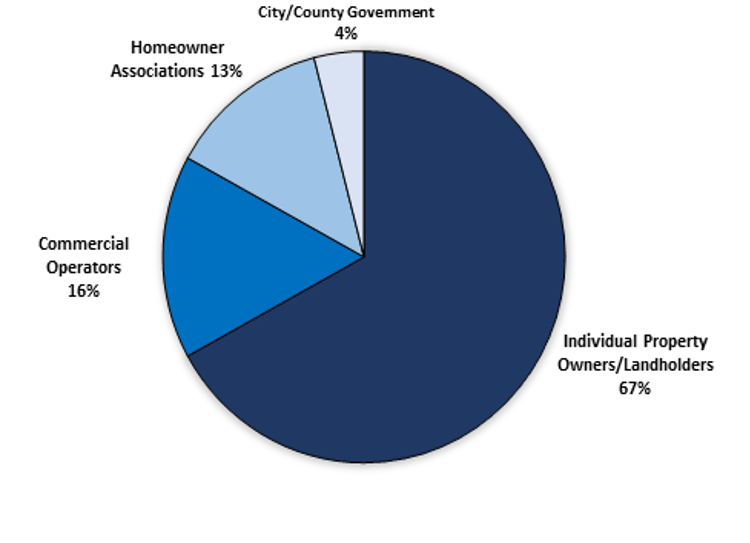
Next, the agents rated the importance of various challenges and barriers to meeting clients' needs (Figure 2). Seventy percent of 56 respondents indicated that the lack of general information available on the topic of forest health was an important challenge. Fifty-nine percent of 56 respondents indicated that the organization (or lack thereof) of the university's Extension publication system created a challenge to meeting clients' needs. Additionally, 55% of 55 respondents indicated that there were not enough specialists in natural resources/forestry to assist in meeting clients' needs.
Figure 2.
Challenges and Barriers to Meeting Clients' Tree and Forest Health Needs
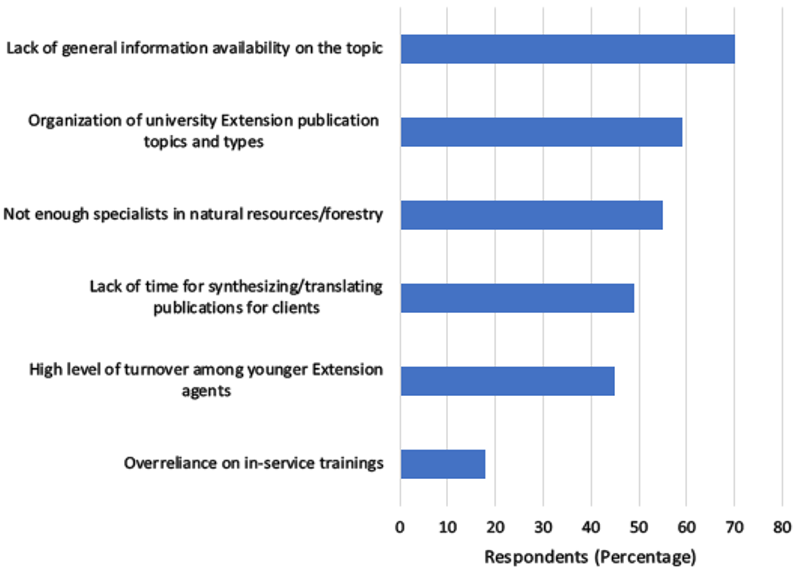
Agents also rated the importance of creating new educational materials for various tree and forest health topics (Figure 3). Of 57 respondents, 91% found it important to create materials on tree disease, 91% found it important to create materials on pest identification, and 84% found it important to create materials on invasive and exotic species.
Figure 3.
Tree and Forest Health Topics for Which Educational Materials Are Needed
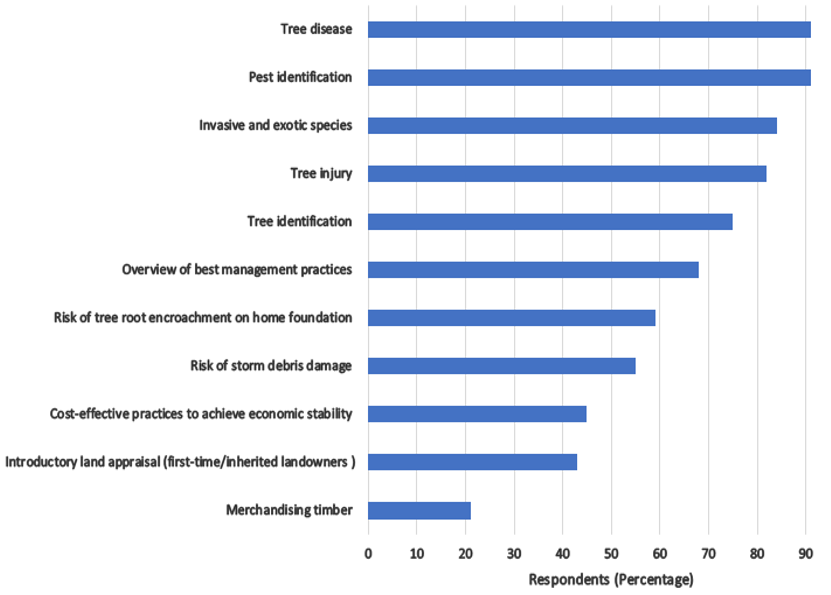
We asked agents to review a list of formats that could be used for new educational materials and indicate which options would be most useful for addressing their clients' needs (Figure 4). Eighty-six percent of 56 respondents identified factsheets/infographics as useful, 81% of 57 respondents identified peer-reviewed Extension publications as useful, and 71% of 56 respondents suggested that handbooks and "how-to" guides would be useful.
Figure 4.
Educational Material Formats Useful for Addressing Clients' Tree and Forest Health Needs
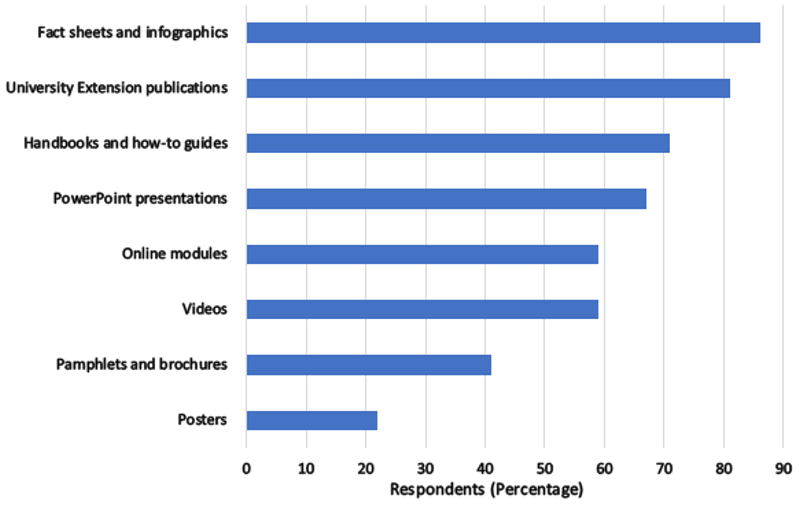
After identifying the usefulness of educational material formats, agents evaluated the importance of various features of educational materials (Figure 5). Of 57 responding agents, 100% indicated that currency of materials is critical for providing useful and relevant information to their clients. Additionally, 95% of 57 respondents confirmed the importance of materials being locally relevant, and 88% of 50 respondents confirmed the importance of materials being visually appealing.
Figure 5.
Features Important for Tree and Forest Health Educational Materials
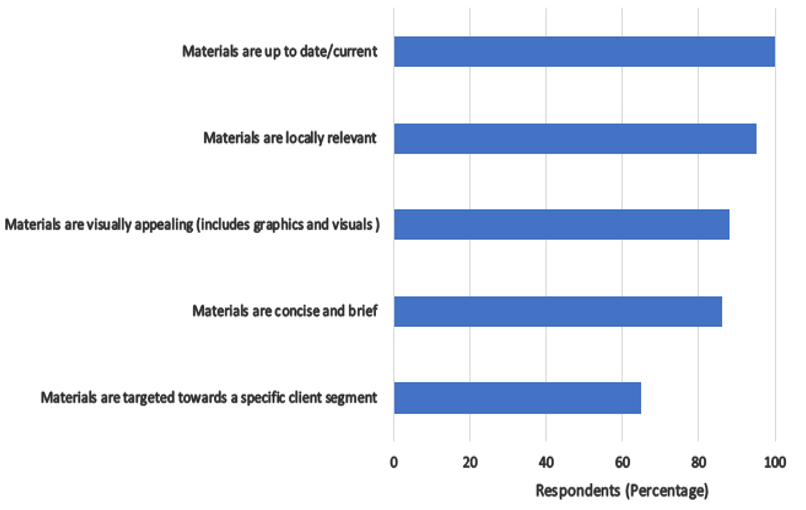
Finally, agents were asked to rate the usefulness of outlets researchers and specialists might use to share tree and forest health information with them (Figure 6). Of 57 responding agents, 81% considered direct email contact useful, 74% found in-service training sessions useful, and 58% identified a shared Dropbox folder as useful.
Figure 6.
Extension Agents' Perceptions of Usefulness of Options for Receiving Tree and Forest Health Information

Conclusion, Implications, and Recommendations
Given the economic and ecological importance of the forestry sector to the southeastern United States and the growing threats to tree and forest health, there is an increasing demand by landowners and land managers for information on appropriate, effective tree and forest health management, especially regarding pest identification and treatment options. There are few existing assessments of how Extension facilitates provision of tree and forest health education to clientele. In our study, we investigated the segmentation of clientele according to the frequency of requests from various groups, and we specifically examined the priorities and needs of Extension personnel regarding educational materials on tree and forest health.
In formative interviews, a group of Extension personnel identified perceived barriers to delivering effective resource support and assistance to clients. These barriers included lack of availability of general information on tree and forest health, lack of trained forestry/natural resources specialists, and difficulty in translating material to be relevant for clients. In these interviews, the Extension personnel also identified key needs for improving client outreach on tree and forest health issues (e.g., the need for educational materials to be up-to-date, locally relevant, and concise). Our qualitative findings, presented in Appendixes A and B, were upheld by the results of the subsequent survey phase of our study. For example, agents' belief that educational materials needed to be locally relevant for their clientele was both a recurrent qualitative theme and a noteworthy survey response, with 95% of agents indicating that locally relevant material was important for clients.
Whereas Sagor et al. (2013) and SREF (2017) identified the interest in and importance of forest health education, our findings demonstrate the challenges that forestry, natural resources, and horticulture/agriculture agents face in effectively resolving client requests. As the primary link between subject specialists and landowners, Extension agents serve a crucial function in the promotion of sustainable forestry management, resiliency, and health. Overall, our results highlight critical barriers faced by Extension agents as they address diverse and shifting tree and forest health requests from clientele. Recommendations we present here are intended to motivate continued research and practical applications for improving tree and forest health resource support in Cooperative Extension. Agents' responses to our survey indicate that tree disease, pest identification, and invasive and exotic species are topics for which new educational materials are needed. We recommend prioritization of content on these topics to help agents field and resolve client requests. As indicated by agents, it is also crucial that publications are up-to-date, locally relevant, and visually appealing. We suggest prioritization of these features in educational materials designed to assist clients in resolving tree and forest health issues.
Agents in our study indicated that there are opportunities for increased communication with subject specialists to improve the efficacy of material outputs and that they have a preference for receiving communications via direct email engagement, in-service training, and shared digital resources (i.e., Dropbox folders). We believe that use of these outlets may improve institutional collaboration and mitigate the perception that there is a lack of accessible subject specialists/researchers in the forestry discipline. Creating better connections with subject specialists, who are often the primary generators of the tree and forest health educational materials used by Extension agents, holds promise for increasing the capacity to address client requests on these topics. To address agents' concern about a perceived lack of collaboration between themselves and subject specialists, we recommend following program models such as ProForest and SREF to recognize and prioritize the creation and support of related multi-institutional collaborative programs.
Finally, as we attempted to address a gap in assessment of tree and forest health educational materials relevant to a broader population of interest (i.e., Extension agents who address tree and forest health issues), our sampling frame included an accessible segment of Extension personnel in Florida. Researchers should consider this limitation when making judgments about the applicability of our findings. Ultimately, however, our exploration demonstrates that there are unique needs and barriers faced by forest health Extension professionals, and, therefore, we recommend that additional studies in different and broader contexts be undertaken.
References
American Forest and Paper Association. (2018). Our economic impacts. Retrieved from https://afandpa.org/advocacy/economic-impact
Aukema, J. E., Leung, B., Kovacs, K., Chivers, C., Britton, K. O., Englin, J., . . . Von Halle, B. (2011). Economic impacts of non-native forest insects in the continental United States. PLoS One, 6(9), e24587. Retrieved from https://journals.plos.org/plosone/article?id=10.1371/journal.pone.0024587
Coulson, R. N., & Stephen, F. M. (2008). Impacts of insects in forest landscapes: Implications for forest health management. In T. D. Paine (Ed.), Invasive forest insects, introduced forest trees, and altered ecosystems (pp. 101–125). Dordrecht, Netherlands: Springer.
Dillman, D. A., Smyth, J. D., & Christian, L. M. (2014). Internet, phone, mail, and mixed-method surveys: The tailored design method. Boston, MA: John Wiley.
Escobedo, F. J., & Timilsina, N. (Eds.). (2012). Stewardship ecosystem services project final report. Gainesville, FL: School of Forest Resources and Conservation, University of Florida.
Gamfeldt, L., Snäll, T., Bagchi, R., Jonsson, M., Gustafsson, L., Kjellander, P., & Mikusiński, G. (2013). Higher levels of multiple ecosystem services are found in forests with more tree species. Nature Communications, 4, 1340. Retrieved from https://www.nature.com/articles/ncomms2328
Hansen, E., & Smith, R. (1997). Assessing educational needs of the forest products industry in Oregon and Virginia. Forest Products Journal, 47(4), 36. Retrieved from https://search-proquest-com.lp.hscl.ufl.edu/docview/214633955?pq-origsite=gscholar
Kolb, S. M. (2012). Grounded theory and the constant comparative method: Valid research strategies for educators. Journal of Emerging Trends in Educational Research and Policy Studies, 3(1), 83–86. Retrieved from http://citeseerx.ist.psu.edu/viewdoc/download?doi=10.1.1.301.9451&rep=rep1&type=pdf
Lovett, G. M., Weiss, M., Liebhold, A. M., Holmes, T. P., Leung, B., Lambert, K. F., . . . Wildova, R. (2016). Nonnative forest insects and pathogens in the United States: Impacts and policy options. Ecological Applications, 26(5), 1437–1455. Retrieved from https://esajournals.onlinelibrary.wiley.com/doi/full/10.1890/15-1176
Millar, C. I., & Stephenson, N. L. (2015). Temperate forest health in an era of emerging megadisturbance. Science, 349(6250), 823–826. Retrieved from https://science.sciencemag.org/content/349/6250/823
Pokorny, J. (1998). Urban forest health needs assessment survey: Results and recommendations. Retrieved from https://www.fs.usda.gov/naspf/sites/default/files/publications/07_na-tp-01-98_urban_forest_health_needs_assessment_survey_508c.pdf
Sagor, E. S., Kueper, A. M., Blinn, C. R., & Becker, D. R. (2013). Extension forestry in the United States: A national review of state-level programs. Journal of Forestry, 112(1), 15–22. Retrieved from https://academic-oup-com.lp.hscl.ufl.edu/jof/article/112/1/15/4599691
Southern Regional Extension Forestry. (2017). 2017 SREF needs assessment summary. Retrieved from https://sref.info/resources/publications/2017-sref-needs-assessment-summary/at_download/file
Vose, J. M., Peterson, D. L., & Patel-Weynand, T. (2012). Effects of climatic variability and change on forest ecosystems: A comprehensive science synthesis for the US (Gen. Tech. Rep. PNW-GTR-870). Portland, OR: U.S. Department of Agriculture, Forest Service, Pacific Northwest Research Station.
Zobrist, K. W., & Rozance, M. A. (2015). Forest landowner education interests and delivery preferences: A retrospective look at survey results and actual participation. Journal of Extension, 53(5), Article 5FEA6. Available at: https://www.joe.org/joe/2015october/a6.php
Appendix A
Qualitative Themes from First-Phase Phone Interviews
| First-tier categories | Second-tier themes |
| Institutional communication/relationship with subject specialists | Not enough specialists in natural resources High generational turnover In-service training as a primary communication/relationship pathway Collaboration/interfacing frequency |
| Clientele priorities, barriers and needs | Cost-effectiveness/economic solvency of property Land appraisals and tax exemptions Best management practices Tree and pest identification Simple, brief and accessible content |
| Agent priorities, barriers, and needs | Pubs for smallholder/rancher clientele Tree and pest identification keys in publications Program area conflicts Prioritizing material synthesis Better Electronic Data Information Source organization Encouraging more general natural resources content in databases |
| Sources and features of educational material used | Locally relevant Audience-targeted Updated Visually appealing (images) Concise/brief |
| Frequency/type of forest health related questions | Tree disease/injury Tree pests Invasive species Merchandising timber Risk of storm debris/foundation encroachment Appropriate plant placement and removal Strategic planning/conservation |
Appendix B
Qualitative Key Findings from First-Phase Phone Interviews
| Key finding | Exemplar quote |
| Collaboration/interfacing with natural resource researchers and subject specialists can be generally infrequent and rarely prioritized | . . .but a lot of times those specialists, they do what they want to do, and if they produce any of this document that helps me out, great. And if I need, have a question, I'll call them up and ask them a question, but nobody's ever asked me: what do you think we need to be working on? |
| High turnover rates with designated subject specialists/researchers can impede relationship building with Extension personnel (and vice-versa) | And it's because the turnover in the industry, and at least the landscape industry, is so high that folks just have no working knowledge of what some of the problems out there are. |
| Clientele are more solution-oriented than process-oriented - they want simple, concise and brief materials | They're looking for information. . .to solve a problem. And they're looking for immediate information to solve a problem that they have right in front of them. You know, they're not looking for all this background information. |
| Agents prioritize synthesizing educational forestry materials to be more targeted and relevant for their clientele | When I'm answering questions that relate to forest health or forestry in my area, I do tend to need to rewrite things to be specific to our soil type or our immediate area on most of the statewide documents. |
| Agents find high value in segmenting/targeting their client base to improve the output of materials and quality of outreach | So demographic issues should be a functional part of how we respond to situations where we educate people. It's absolutely important, I believe. |
| Materials need to be direct, concise & brief to be practically useful for agents to pass onto most client segments | You know. . .some of the documents we get are simply difficult to read. And everyone who is reading one of these things is not expecting to be opening the beginning of a chapter of a textbook on the subject. |
| The questions most related to conservation/strategic planning, or appropriate ornamental/native tree scaping (i.e., proper plant placement or removal) are expressed mainly by urban/municipal clients | I do think the questions I deal with are important to overall forest health, especially urban forest health. When our Florida Friendly Landscaping and horticulture agent, when they're talking to the city about trees, they're talking about a specific tree or a specific group of trees. When I talk to one of our municipalities about trees, I'm interested in overall canopy health, canopy diversity, and age, and species, and how resilient that urban forest will be to pests, or weather, or whatever other craziness that can happen in a city. |




